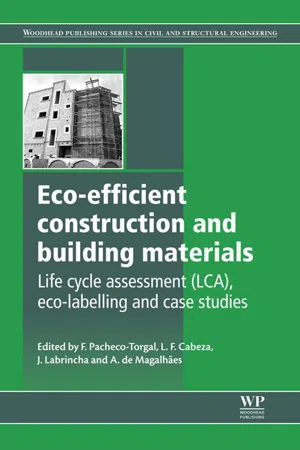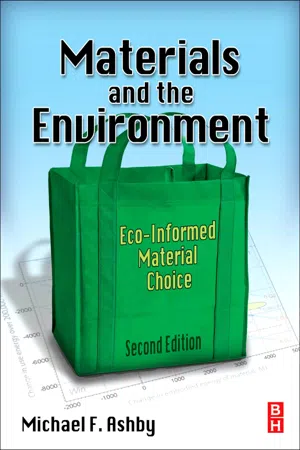Environmental Impact of Materials
The environmental impact of materials refers to the effects that the extraction, production, use, and disposal of materials have on the environment. This includes factors such as resource depletion, energy consumption, pollution, and waste generation. Assessing and minimizing the environmental impact of materials is crucial for sustainable development and responsible resource management.
6 Key excerpts on "Environmental Impact of Materials"
- Arshad Ahmed, John Sturges(Authors)
- 2014(Publication Date)
- Routledge(Publisher)
...Part IV Conclusion: sustainability of materials 22 Environmental Impact of Materials This chapter examines the nature and extent of the impact that the extraction, production and use of building materials has on the Earth’s natural environment. It examines the steps involved in producing the materials, and the total life cycle impact from cradle to grave. Most importantly, various ways of quantifying the impact are set out in this chapter, as well as suggestions for mitigating the various adverse effects described. Contents 22.1 Introduction 22.2 Materials 22.2.1 Construction materials and their importance 22.3 Energy 22.4 Stages in material production and use 22.5 Measurement of environmental impact 22.6 Indices of environmental impact 22.6.1 Embodied energy 22.6.2 Embodied carbon dioxide 22.6.3 Water usage 22.6.4 Material intensity factor 22.6.5 Ecological footprint 22.6.6 Other types of environmental impact 22.7 Durability/longevity issues 22.8 End of life issues 22.9 Conclusions 22.10 Critical thinking and concept review 22.1. Introduction We have already alluded to the fact that construction uses a wider range of materials than any other industry, as well as the fact that it consumes more material than all other industries put together. Since 1900 the Earth’s population has more than trebled, from around 1.8 billion to around 7.0 billion people (as of 2012). All of these people need somewhere to live, and since construction exists to provide buildings, the industry is having a huge influence on life on Earth. In Chapter 1 we saw that the unprecedented growth in demand for materials by the construction sector of industry since the Second World War is having a major impact. In this chapter we shall examine the reasons for this impact and also the ways in which it is being felt...
- eBook - ePub
Sustainable Construction Technologies
Life-Cycle Assessment
- Vivian Y. Tam, Khoa N. Le(Authors)
- 2019(Publication Date)
- Butterworth-Heinemann(Publisher)
...However, a lot remains to be done in both developed and developing countries. The sustainability of building materials can be better understood by examining their environmental impact. Relying on extant literature, this chapter examines the importance of materials in general and sustainable materials in particular to the attainment of sustainable construction. Also, the environmental impacts of building materials are examined from the perspective of life cycle assessment (LCA) with focus on embodied energy and carbon emissions. An overview of the LCA framework is examined and results from LCA studies used as a validation of the various approaches to sustainable construction subsequently outlined. The chapter further underscored the implications of the study findings especially with respect to the creation of an enabling institutional environment as main driver of sustainable construction. Also, the application of LCA results early in the project life cycle was recommended. In this respect, the need for environmental information on materials to be readily available so as to facilitate easy reference at design and specification stage of construction projects was stressed. 9.2 Environmental Impact of Buildings Buildings exert a lot of impact on the environment through material consumption, construction methods, use, and deconstruction. Building materials are almost entirely made from nonrenewable natural resources, which provide the major inputs to the production processes. There has been unprecedented growth in the demand for raw materials for the purpose of production due mainly to rapid urbanization and economic development (OECD, 2012). For example, mining of natural resources either for construction or as inputs for production of other materials has environmental, economic, and social consequences. One of such environmental consequences is pollution of both the air and waterways (Mensah et al., 2015)...
- eBook - ePub
Eco-efficient Construction and Building Materials
Life Cycle Assessment (LCA), Eco-Labelling and Case Studies
- Fernando Pacheco-Torgal, Luisa F. Cabeza, Joao Labrincha, Aldo Giuntini de Magalhaes(Authors)
- 2014(Publication Date)
- Woodhead Publishing(Publisher)
...1 Introduction to the environmental impact of construction and building materials F. Pacheco-Torgal University of Minho, Portugal Abstract Earth’s natural resources are finite and face increasing human pressure. Over the last few decades, concern has been growing about resource efficiency and the environmental impact of material consumption. The construction industry is responsible for the consumption of a relevant part of all produced materials, however, only recently has this industry started to worry about its environmental impacts. This chapter highlights relevant landmarks on sustainable development, materials efficiency and on the assessment of the environmental impact of construction products. An overview on the European Construction Products Regulation (CPR) enforced since the 1 July 2013 is given followed by an outline of the book. Key words sustainable development materials efficiency environmental impact LCA eco-labels product self-declarations 1.1 Introduction Four decades ago, several investigators used a computer model based on the fixed-stock paradigm to study the interactions between population, food production, industrial production, pollution and the consumption of non-renewable resources. They predicted that during the 21st century, the Earth’s capacity would be exhausted, resulting in the collapse of human civilisation as we know it (Meadows et al., 1972). Two decades later, an update of this study was published showing that some limits had already been crossed (Meadows et al., 1992).Whilst the particular assumptions and predictions of such studies have been questioned, there is general agreement that may of the Earth’s key resources are finite and must be conserved...
- eBook - ePub
Net Zero Energy Buildings (NZEB)
Concepts, Frameworks and Roadmap for Project Analysis and Implementation
- Shady Attia(Author)
- 2018(Publication Date)
- Butterworth-Heinemann(Publisher)
...In this chapter, we aim to understand the environmental implications of building materials and their complex and multi-criteria attributes. This includes products such as concrete, masonry, wood, plastics, composites, thermal and moisture protection, openings, finishes, equipment, furnishing, plumbing, and electrical wiring. Also, we explore the policies, recent trends, and best practices of building structural systems and ecological materials. Finally, the chapter provides a critical discussion on the environmental consequences of building materials used for NZEB. 2 Building Materials Environmental Impact NZEB are realized by lowering the energy demand through passive design and energy conservation measures, and by generating energy that meets this demand on-site. Both strategies have implications on the building construction system, technology and materials selection for the envelope, systems, and finishes. Worldwide, 50% if all extracted materials are delivered to serve the built environment (CESBA, 2014). At the same time, the consumption of material resources is increasing significantly to meet humans’ living standards and the development of modern societies. There is sufficient empirical evidence that the use of building materials has a negative environmental impact associated with extraction, processing, transport, maintenance, and disposal. In this section, we will briefly present the environmental and health impact of building materials in relation to the linear exploitation and disposal process. 2.1 Environmental Impact Around 50% of all extracted materials are used by the building industry. Building construction and operation contribute greatly to resource depletion and consumption. The increased level of building material consumption worldwide leads to land use, land deforestation, soil erosion and degradation, and more mined minerals...
- eBook - ePub
Materials and the Environment
Eco-informed Material Choice
- Michael F. Ashby(Author)
- 2012(Publication Date)
- Butterworth-Heinemann(Publisher)
...Chapter 3 The material life cycle Contents 3.1 Introduction and synopsis 3.2 The design process 3.3 The materials life cycle 3.4 Life-cycle assessment: details and difficulties 3.5 Streamlined LCA and eco-auditing 3.6 The strategy 3.7 Summary and conclusions 3.8 Further reading 3.9 Appendix: software for LCA 3.10 Exercises Image of casting courtesy of Skillspace; image of car making courtesy of US Department of Energy EERE program, image of cars courtesy of Reuters.com) 3.1 Introduction and synopsis The materials of engineering have a life cycle. Materials are created from ores and feedstock. These are manufactured into products that are distributed and used. Products, like us, have finite life, at the end of which they become scrap. The materials they contain, however, are still there; some, unlike us, can be resurrected and enter a second life as recycled content in a new product. Life-cycle assessment (LCA) traces this progression, documenting the resources consumed and the emissions excreted during each phase of life. The output is a sort of biography, documenting where the materials have been, what they have done, and the consequences of this for their surroundings. It can take more than one form. It can be a full LCA that scrutinizes every aspect of life (arduous and expensive in time and money); or it can be a brief character-sketch painting, an approximate (but still useful) portrait; or it can be something in between. Responsible design, today, aims to provide safe, affordable services while minimizing the drain on resources and the release of unwanted emissions. To do this, the designer needs an ongoing eco-audit of the design (or redesign) as it progresses. To be useful the eco-audit must be fast, allowing quick “what if?” exploration of the consequences of alternative choices of material, use pattern, and end-of-life scenarios...
- eBook - ePub
The ELSI Handbook of Nanotechnology
Risk, Safety, ELSI and Commercialization
- Chaudhery Mustansar Hussain, Chaudhery Mustansar Hussain(Authors)
- 2020(Publication Date)
- Wiley-Scrivener(Publisher)
...Nanotechnological products are considered to bring benefits and offer challenges for better optimization of natural resources use and environmental protection. They are marketed in various sectors such as healthcare (regenerative medicine, targeted drug delivery, and diagnostics as indicated by patent analysis), cosmetics, electronics, textiles, information technology, and environmental protection. Mass production of nanomaterials will take place, along with the implication of potential wide-scale exposure of workers and consumers as well as the environment [ 2 ]. Nanotechnology applications that directly benefit the environment are nanotechnologies for site remediation and wastewater treatment [ 3 ], nanomaterial-based solar cells for improved energy efficiency, the use of nano-catalysts for air purification [ 4 ], and nanostructured filters or nano-reactive membranes for water purification [ 5 ]. To address the potential impact of manufactured nanomaterial on both environmental and human health is a natural application of this methodology in which using life cycle assessment (LCA) as a suitable tool to achieve the target is essential [ 6 ]. In addition, numerous organizations have pointed out that evaluation of nanomaterials can be done from a life cycle perspective. The potential impact of nanomaterials on the environment could be more far-reaching than the potential impact on human health of free nanoparticles [ 7, 8 ]. The widespread use of nanotechnology seems to benefit many filed applications where there could be unintended health and environmental risks associated with its use. To understand the potential problems of nanomanufacturing, there is a need to use life cycle risk assessment and adopt methods of green manufacturing of nanomaterials to decrease its burden or impact on human and environmental health [ 9 ]. Today, an increase in awareness of the potential risks associated with manufactured nanomaterials are observed...





